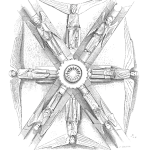
Reliable operations are far less expensive to maintain and operate and they produce more consistently. Yet most industrial operations are far from achieving high reliability. Getting there will require effort and that effort goes well beyond the maintenance department alone. They will need to change from reactive, break it then fix it thinking and un-informed cost-cutting measures that undermine reliability. They will need leadership, not management. Leadership is all about making change and taking your organization in new directions. It will be disruptive, or it won’t be much of a change. Leaders are the ones who rock the boat, managers will keep it stable. In choosing excellence you’ll be choosing a path of constant change and improvement. Leadership is needed – it’s about strategy, effective execution, and it’s about your people – without whom you will accomplish very little. If you want excellence, it begins with leadership.
Maintenance is an important business function. Lately, I’ve been thinking about maintenance as little more than a team that executes a reliability strategy. It sustains your productive capacity. It is a part of your fixed and variable costs. Reducing maintenance costs through efficiency gains (doing maintenance the right way) and effectiveness (doing the right things) increases operating margins. Just as it contributes substantially to the company’s safety and environmental performance, it also impacts on how financially “risky” the business is.
Productive assets that are well maintained can meet production commitments more easily and at reduced risks. That’s something that markets, lenders and insurers like to see. If you are building a new plant consider the importance of reliability at the design stage when you have the greatest opportunity to reduce life cycle operating and maintenance costs. All of these are factors to consider in developing your reliability strategy.
Strategy can be as simple or as complex as you like, but simple works best. Your business objectives, the asset environment, its present state and the state of maintenance management practices are your starting points. Understand what it means to be a high performer and using successful practices.
What’s “best” for your company is what works “best” within your company – there are no absolute “best” practices. What works well in one organization may fail in another. Decide what you’d like to achieve – that’s your “vision”. Compare what you do today with that vision and consider using successful practices, such as those described in Uptime, to close any gaps. Involve your people in the process – let them take ownership of where you are today and what must be done to achieve what they see as an attainable vision for the future.
Plan the improvement activities and manage them like any other improvement project. Execution is what matters – that’s choosing.
Some companies choose to outsource maintenance. Do it for the right reasons, and there are many possible. Transferring your problem to someone else may not be the answer. Outsourcing only a part of it can be quite harmful if handled poorly. If maintenance is of strategic importance or it’s unique to your business you are probably best to keep it in house.
Once you’ve embarked on making improvements, then it’s important to sustain them. Excellence is a journey, not a destination. Never let up – as one friend puts it, you must apply gentle pressure relentlessly. You’ll know if it’s working when you find yourself dealing with new problems every year and not repeating the same mistakes.
Learn about Uptime:
Our book on maintenance management is used world-wide, by companies and in training programs. It is even referenced in standards. The model is simple, inclusive and easily remembered. Implementation goes well beyond the technical practices though. Today I strongly recommend that you forget about costly assessments. They usually create resistance to change and slow you down. Talk to us about our proprietary approach that begins with education, costs less, and takes a lot less time.
 Ask a question or send along a comment.
Please login to view and use the contact form.
Ask a question or send along a comment.
Please login to view and use the contact form.
Leave a Reply